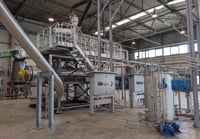Complete privacy policy for actual and potential customers
Complete privacy policy for actual and potential customers
Report broken links or give feedback

Shipping record-sized Yankee cylinder
Valmet recently shipped a record-sized Yankee cylinder from its production site in Karlstad, Sweden, to a customer in Europe. This impressive cylinder, the largest ever manufactured in Karlstad, has a diameter of nearly seven meters and weighs over 200 tons—30 tons more than the previous largest.
Insights ● Video
VII for Paper Quality
How do I use Industrial internet to lower variations and increase end product quality?
Services
Supplier sustainability engagement program
Company

Valmet Refiner Segments for LC refining
Valmet offers the industry’s widest, most trusted portfolio of patented and customized refiner segments for low consistency refining. Reach energy savings, shive reductions, freeness improvement, longer segment lifetime and more with Valmet Refiner Segments.
Services
Sustainability at Valmet
Sustainability is at the core of Valmet's business strategy and operations. Our values, Code of Conduct, related policies, and selected globally acknowledged initiatives and principles create the foundation for sustainable performance at Valmet.
Company
Positive results for Valmet BioTrac Technology in Italian project
Valmet has worked in close cooperation together with Hera Group and Ayrion to develop an innovative prototype based on the Valmet BioTrac pretreatment technology. It is part of the Life Steam project* with the ambition to effectively pretreat green waste before sending it to anaerobic digestion. After months of intense work, the project is coming to an end and is showing good results.
Insights ● Article
Roll reconditioning services
Valmet’s roll reconditioning services include thorough inspections of present roll condition and proposals for maintenance work needed to bring component to “as new” condition.
Services
Towards more autonomous operations
Valmet's framework for autonomous operations describes the levels of autonomy and the main building blocks that are needed to move towards it.
Automation solutions